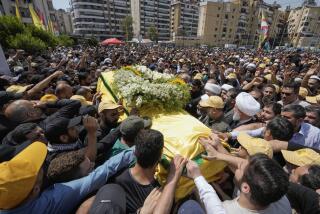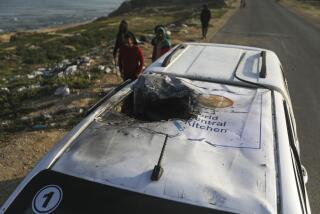Terror Cell Broken Up, Israel Says
- Share via
JERUSALEM — Israeli security officials said Wednesday that they have cracked a Hamas cell based in East Jerusalem whose members exploited Israeli identity cards to carry out some of the most frightening bombing attacks in recent months, including one at Hebrew University that killed five Americans and four Israelis.
A total of 15 people were arrested last weekend in Jerusalem and in the West Bank, security officials said. Among them, the officials said, is a Palestinian painter who worked at Hebrew University and is suspected of planting an explosives-packed bag in the Frank Sinatra Student Center’s cafeteria during lunchtime on July 31.
The officials said the cell was also responsible for a deadly bombing at a crowded, trendy cafe across the street from the prime minister’s residence here in March and, perhaps most significant, a string of attacks on strategic targets, including railways and Israel’s main fuel depot.
“This was an especially creative group,” one security agent said. The cell plotted operations that not only could cause deaths but also had the potential to cause severe damage to the Israeli economy, as well as the transportation and communications infrastructure, he said.
Hamas, a radical Islamic movement that advocates the destruction of Israel, has been active in East Jerusalem but rarely on this scale, the officials said.
All told, the cell was responsible for eight attacks, 35 deaths and scores of injuries, the officials said.
The arrests were announced at a rare briefing for foreign journalists by Israel’s domestic General Security Service, known as the Shin Bet. The agents spoke on the condition that they not be identified by name.
The agents emphasized the use by the cell members of Israeli identity cards that facilitated their movement in Jerusalem and throughout Israel. Thousands of Arab residents of the city, in contrast to Palestinians who live in the West Bank, hold Israeli identity cards that entitle them to some benefits, such as social security and freer movement.
“They misused their ... status to gather information and to move and carry out terror attacks,” said a senior official with the Shin Bet. “They put deep thought behind this plan. They didn’t pick targets by chance.”
Politicians responded to the news with calls to revoke the citizenship of Israeli Arabs involved in terrorist acts and to demolish their homes, a measure already employed by the army against West Bank Palestinians.
Although the Shin Bet agents were careful to say the existence of the cell did not implicate all Arabs of East Jerusalem, Prime Minister Ariel Sharon’s office made less of a distinction.
“The implications directly damage the trust given to residents of eastern Jerusalem who could pay a dear social and economic price as a result of being alienated from the Jewish population, and as a result of being considered as suspicious in all areas,” said a statement from the office.
The security officials said they had pieced together the identities of the cell members through intelligence, including Arab informants and surveillance. They learned that the group was planning another large-scale attack last Saturday and staked out their designated meeting place. Shin Bet, police and army units intercepted one suspect, Wissam Abassi, 25, at a roadblock near the site on Jerusalem’s northern edge, then gave chase after two others, Wael Kassem, 31, and Alah Abassi, 30, who allegedly fled with a bomb.
The pair were caught in central Jerusalem after ditching the bomb, officials said. Within hours, two additional suspects, Mohammed Odeh, 29, and Mahmed Arman, 27, were arrested at their homes. The security officials named Arman as the ringleader. Odeh is the painter who worked at Hebrew University.
All but Arman live in East Jerusalem.
Three days after the arrests, police found a concealed bomb alongside the main Jerusalem-Tel Aviv highway and defused it in an operation that tied up traffic for hours.
Details were not available on the capture of the other 10 suspects, who were from the West Bank.
Through their interrogations of Odeh, the security officials said they learned new details of how the Hebrew University attack was carried out. Odeh had easy access to the campus by virtue of his job. He smuggled the bomb in a bag onto the campus one night and hid it in the bushes, the officials said. The next day, they say, he picked up the bomb and left it on a table in the cafeteria, covered with an Israeli newspaper. From the outskirts of the campus he allegedly detonated the explosive with a cellular phone call.
Odeh chose a cafeteria where he believed few Arabs would be eating or working, the officials said. He was aware that foreigners would be present, they said.
The day after the cafeteria blast, Odeh was among the workers brought in to repair and paint the damage, the officials said.
Samir Odeh denied Wednesday evening that his brother was guilty of anything.
“He goes to work and then he goes home, and he’s not involved in any [radical] movements,” Samir Odeh told Israeli television.
The orders behind the attacks, the planning and the explosives originated in the West Bank city of Ramallah and reached the cell in East Jerusalem, the officials said. Two of the attacks attributed to the cell involved suicide bombings--the cafe in March and a pool hall in May--but the rest involved explosives activated by remote control.
In part, the agents said, the shift in tactics reflected a desire to preserve assets as valuable as the men with Israeli identity cards had proved to be.
More to Read
Sign up for Essential California
The most important California stories and recommendations in your inbox every morning.
You may occasionally receive promotional content from the Los Angeles Times.











